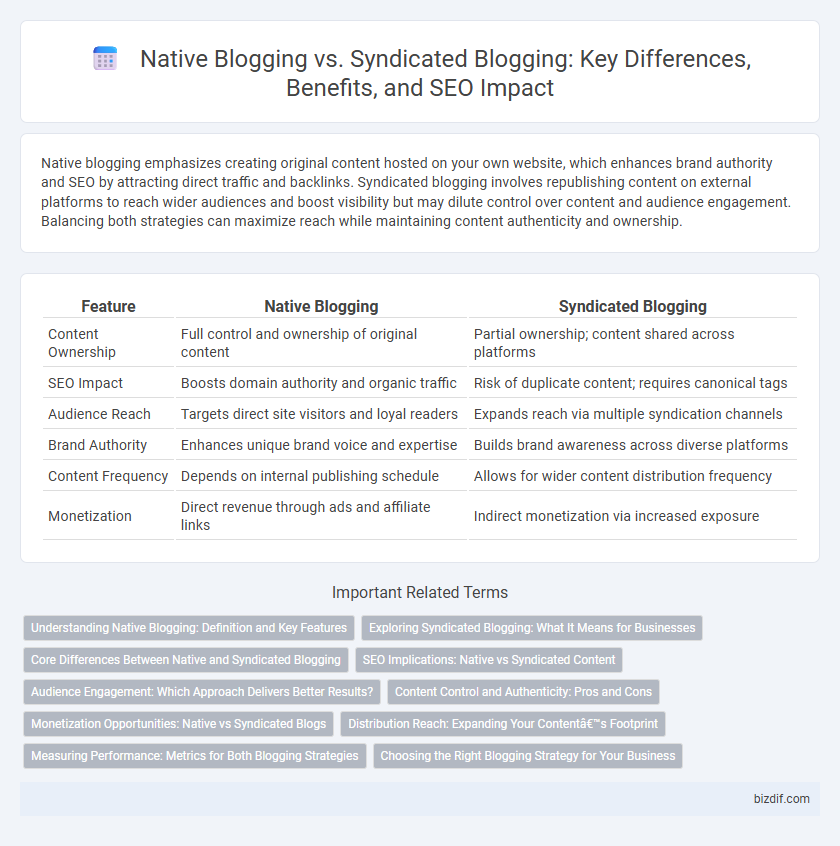Native blogging emphasizes creating original content hosted on your own website, which enhances brand authority and SEO by attracting direct traffic and backlinks. Syndicated blogging involves republishing content on external platforms to reach wider audiences and boost visibility but may dilute control over content and audience engagement. Balancing both strategies can maximize reach while maintaining content authenticity and ownership.
Table of Comparison
| Feature | Native Blogging | Syndicated Blogging |
|---|---|---|
| Content Ownership | Full control and ownership of original content | Partial ownership; content shared across platforms |
| SEO Impact | Boosts domain authority and organic traffic | Risk of duplicate content; requires canonical tags |
| Audience Reach | Targets direct site visitors and loyal readers | Expands reach via multiple syndication channels |
| Brand Authority | Enhances unique brand voice and expertise | Builds brand awareness across diverse platforms |
| Content Frequency | Depends on internal publishing schedule | Allows for wider content distribution frequency |
| Monetization | Direct revenue through ads and affiliate links | Indirect monetization via increased exposure |
Understanding Native Blogging: Definition and Key Features
Native blogging involves creating original content published directly on your own blog, enhancing brand authority and SEO by driving organic traffic. Key features include full control over content, tailored audience engagement, and the ability to optimize posts for search engines using targeted keywords. This approach contrasts with syndicated blogging, where content is republished on external platforms, potentially diluting traffic and editorial control.
Exploring Syndicated Blogging: What It Means for Businesses
Syndicated blogging enables businesses to reach wider audiences by republishing content on third-party platforms, thereby amplifying brand visibility and driving traffic back to their original site. Leveraging syndicated content can enhance SEO through diverse backlinks and consistent content distribution across multiple channels. However, businesses must maintain content originality and monitor syndication quality to preserve brand reputation and maximize engagement.
Core Differences Between Native and Syndicated Blogging
Native blogging involves creating original content published directly on a brand's own platform, enhancing SEO through unique, targeted keywords and fostering stronger brand authority. Syndicated blogging republishes existing articles across multiple platforms, increasing reach and visibility but potentially diluting SEO value due to duplicate content issues. Core differences center on content originality, control over distribution, and SEO impact, with native blogging offering greater customization and sustained traffic benefits.
SEO Implications: Native vs Syndicated Content
Native blogging enhances SEO by creating unique, original content that boosts site authority and improves search engine rankings through increased user engagement and lower bounce rates. Syndicated blogging, while expanding reach by republishing content on multiple platforms, can lead to duplicate content issues, potentially harming search rankings if not properly managed with canonical tags. Prioritizing native content ensures better control over SEO signals, whereas syndicated content requires strategic implementation to maintain SEO value.
Audience Engagement: Which Approach Delivers Better Results?
Native blogging boosts audience engagement by providing unique, tailored content that resonates directly with the target readership, fostering loyalty and higher interaction rates. Syndicated blogging expands reach by distributing content across multiple platforms, increasing visibility but often diluting personalized engagement. Data shows native blogs achieve 30% higher average time-on-page and 25% more comments compared to syndicated posts.
Content Control and Authenticity: Pros and Cons
Native blogging offers full content control and fosters authentic expression, enhancing brand voice consistency and trustworthiness. Syndicated blogging expands reach by republishing articles on multiple platforms but risks content dilution, loss of originality, and reduced audience engagement. Balancing native blogging for authenticity with syndicated blogging for visibility is crucial for an effective content strategy.
Monetization Opportunities: Native vs Syndicated Blogs
Native blogging offers higher monetization potential through direct ad placements, sponsored content, and affiliate marketing tailored to the blog's unique audience. Syndicated blogs often generate revenue via licensing fees or shared ad revenues but typically face limitations in brand control and exclusive content offers. Maximizing monetization requires leveraging native blogs for targeted engagement while using syndication to expand reach and diversify income streams.
Distribution Reach: Expanding Your Content’s Footprint
Native blogging enhances distribution reach by leveraging the original platform's audience, fostering deeper engagement and brand loyalty. Syndicated blogging expands content footprint across multiple channels, increasing visibility and attracting diverse demographics. Combining both strategies optimizes reach by balancing focused community interaction with broader exposure.
Measuring Performance: Metrics for Both Blogging Strategies
Measuring performance in native blogging involves tracking metrics such as organic traffic, user engagement, and conversion rates on the original site, providing direct insights into audience behavior and content effectiveness. Syndicated blogging performance is assessed through referral traffic, backlink quality, and social shares on third-party platforms, highlighting content reach and brand amplification. Comparing these metrics helps determine content ROI and informs strategic decisions for optimizing content distribution and audience growth.
Choosing the Right Blogging Strategy for Your Business
Native blogging, where original content is published on your own website, enhances brand authority and improves SEO by driving organic traffic directly to your domain. Syndicated blogging involves republishing content on third-party platforms, expanding reach and attracting diverse audiences but with less control over SEO benefits. Selecting the right strategy depends on your business goals: prioritize native blogging for long-term brand building and SEO or leverage syndicated blogging for rapid audience growth and increased exposure.
Native Blogging vs Syndicated Blogging Infographic

 bizdif.com
bizdif.com